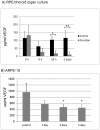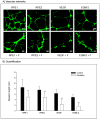Fucoidan reduces secretion and expression of vascular endothelial growth factor in the retinal pigment epithelium and reduces angiogenesis in vitro
- PMID: 24558482
- PMCID: PMC3928431
- DOI: 10.1371/journal.pone.0089150
Fucoidan reduces secretion and expression of vascular endothelial growth factor in the retinal pigment epithelium and reduces angiogenesis in vitro
Abstract
Fucoidan is a polysaccharide isolated from brown algae which is of current interest for anti-tumor therapy. In this study, we investigated the effect of fucoidan on the retinal pigment epithelium (RPE), looking at physiology, vascular endothelial growth factor (VEGF) secretion, and angiogenesis, thus investigating a potential use of fucoidan for the treatment of exudative age-related macular degeneration. For this study, human RPE cell line ARPE-19 and primary porcine RPE cells were used, as well as RPE/choroid perfusion organ cultures. The effect of fucoidan on RPE cells was investigated with methyl thiazolyl tetrazolium--assay, trypan blue exclusion assay, phagocytosis assay and a wound healing assay. VEGF expression was evaluated in immunocytochemistry and Western blot, VEGF secretion was evaluated in ELISA. The effect of fucoidan on angiogenesis was tested in a Matrigel assay using calcein-AM vital staining, evaluated by confocal laser scanning microcopy and quantitative image analysis. Fucoidan displays no toxicity and does not diminish proliferation or phagocytosis, but reduces wound healing in RPE cells. Fucoidan decreases VEGF secretion in RPE/choroid explants and RPE cells. Furthermore, it diminishes VEGF expression in RPE cells even when co-applied with bevacizumab. Furthermore, fucoidan reduces RPE-supernatant- and VEGF-induced angiogenesis of peripheral endothelial cells. In conclusion, fucoidan is a non-toxic agent that reduces VEGF expression and angiogenesis in vitro and may be of interest for further studies as a potential therapy against exudative age-related macular degeneration.
Conflict of interest statement
Figures







Similar articles
-
Fucoidan as a Potential Therapeutic for Major Blinding Diseases--A Hypothesis.Mar Drugs. 2016 Feb 3;14(2):31. doi: 10.3390/md14020031. Mar Drugs. 2016. PMID: 26848666 Free PMC article. Review.
-
Interaction of High-Molecular Weight Fucoidan from Laminaria hyperborea with Natural Functions of the Retinal Pigment Epithelium.Int J Mol Sci. 2023 Jan 23;24(3):2232. doi: 10.3390/ijms24032232. Int J Mol Sci. 2023. PMID: 36768552 Free PMC article.
-
Influence of a Very High-Molecular Weight Fucoidan from Laminaria hyperborea on Age-Related Macular Degeneration-Relevant Pathomechanisms in Ocular Cell Models.Mar Drugs. 2025 Feb 25;23(3):101. doi: 10.3390/md23030101. Mar Drugs. 2025. PMID: 40137287 Free PMC article.
-
Long-term treatment with anti-VEGF does not induce cell aging in primary retinal pigment epithelium.Exp Eye Res. 2018 Jun;171:1-11. doi: 10.1016/j.exer.2018.03.002. Epub 2018 Mar 6. Exp Eye Res. 2018. PMID: 29522724
-
Fucoidans as Potential Therapeutics for Age-Related Macular Degeneration-Current Evidence from In Vitro Research.Int J Mol Sci. 2020 Dec 4;21(23):9272. doi: 10.3390/ijms21239272. Int J Mol Sci. 2020. PMID: 33291752 Free PMC article. Review.
Cited by
-
Fucoidan as a Potential Therapeutic for Major Blinding Diseases--A Hypothesis.Mar Drugs. 2016 Feb 3;14(2):31. doi: 10.3390/md14020031. Mar Drugs. 2016. PMID: 26848666 Free PMC article. Review.
-
Marine Derived Strategies Against Neurodegeneration.Mar Drugs. 2025 Jul 31;23(8):315. doi: 10.3390/md23080315. Mar Drugs. 2025. PMID: 40863632 Free PMC article. Review.
-
Influence of Fucoidan Extracts from Different Fucus Species on Adult Stem Cells and Molecular Mediators in In Vitro Models for Bone Formation and Vascularization.Mar Drugs. 2021 Mar 29;19(4):194. doi: 10.3390/md19040194. Mar Drugs. 2021. PMID: 33805470 Free PMC article.
-
Bridging the gap between traditional cell cultures and bioreactors applied in regenerative medicine: practical experiences with the MINUSHEET perfusion culture system.Cytotechnology. 2016 Mar;68(2):179-96. doi: 10.1007/s10616-015-9873-x. Epub 2015 Apr 17. Cytotechnology. 2016. PMID: 25894791 Free PMC article.
-
Interaction of High-Molecular Weight Fucoidan from Laminaria hyperborea with Natural Functions of the Retinal Pigment Epithelium.Int J Mol Sci. 2023 Jan 23;24(3):2232. doi: 10.3390/ijms24032232. Int J Mol Sci. 2023. PMID: 36768552 Free PMC article.
References
-
- Schrader WF (2006) Age-related macular degeneration: a socioeconomic time bomb in our aging society. Ophthalmologe 103: 742–748. - PubMed
-
- Zarbin M (2004) Current concepts in the pathogenesis of age-related macular degeneration. Arch Ophthalmol 122: 598–614. - PubMed
-
- Miller DW, Joussen AM, Holz FG (2003) The molecular mechanisms of age-related macular degeneration. Ophthalmologe 100: 92–96. - PubMed
Publication types
MeSH terms
Substances
LinkOut - more resources
Full Text Sources
Other Literature Sources

